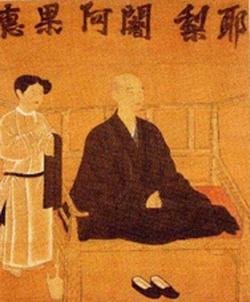Ten factors of life
ten factors of life
十如是 (Jpn ju-nyoze )
Also, ten suchnesses. Ten factors common to all life in any of the Ten Worlds. They are listed in the "Expedient Means" (second) chapter of the Lotus Sutra, which reads: "The true aspect of all phenomena can only be understood and shared between Buddhas. This reality consists of the appearance, nature, entity, power, influence, internal cause, relation, latent effect, manifest effect, and their consistency from beginning to end." This passage provides a theoretical basis for the principle of the replacement of the three vehicles with the one vehicle taught in the theoretical teaching (first half) of the Lotus Sutra. Since the ten factors are common to all life and phenomena, there can be no fundamental distinction between a Buddha and an ordinary person. On this basis, T'ient'ai (538-597) established the philosophical system of three thousand realms in a single moment of life, of which the principle of the ten factors is a component. While the Ten Worlds express differences among phenomena, the ten factors describe the pattern of existence common to all phenomena. For example, both the state of hell and the state of Buddhahood, different as they are, have the ten factors in common.
Briefly, the ten factors are as follows:
(1) Appearance: attributes of things discernible from the outside, such as color, form, shape, and behavior.
(2) Nature: the inherent disposition or quality of a thing or being that cannot be discerned from the outside. T'ient'ai characterizes it as unchanging and irreplaceable. The nature of fire, for instance, is unchanging and cannot be replaced by that of water. He also refers to the "true nature," which he regards as the ultimate truth, or Buddha nature.
(3) Entity: the essence of life that permeates and integrates appearance and nature. These first three factors describe the reality of life itself.
The next six factors, from the fourth, power, through the ninth, manifest effect, explain the functions and workings of life.
(4) Power: life's potential energy.
(5) Influence: the action or movement produced when life's inherent power is activated.
(6) Internal cause: the cause latent in life that produces an effect of the same quality as itself, i.e., good, evil, or neutral.
(7) Relation: the relationship of indirect causes to the internal cause. Indirect causes are various conditions, both internal and external, that help the internal cause produce an effect.
(8) Latent effect: the effect produced in life when an internal cause is activated through its relationship with various conditions.
(9) Manifest effect: the tangible, perceivable result that emerges in time as an expression of a latent effect and therefore of an internal cause, again through its relationship with various conditions. Miao-lo (711-782) regarded the Buddhist law of causality described by the four factors from internal cause to manifest effect as the distinctive characteristic of the ten factors. It concerns the cause and effect for attaining Buddhahood.
(10) Consistency from beginning to end: the unifying factor among the ten factors. It indicates that all of the other nine factors from the beginning (appearance) to the end (manifest effect) are consistently and harmoniously interrelated. All nine factors thus consistently and harmoniously express the same condition of existence at any given moment.
